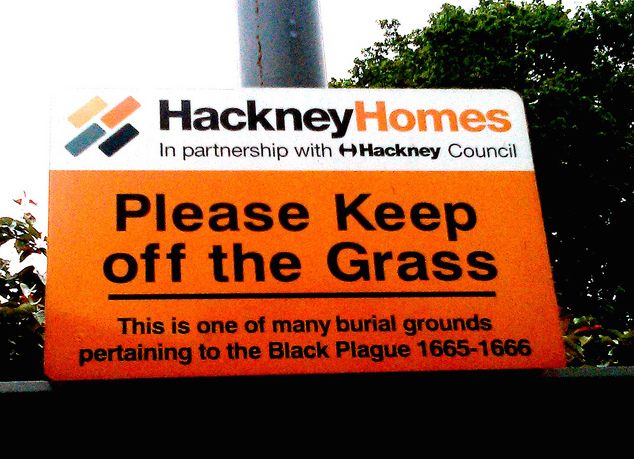London’s Plague Pits Map Shows Where the Black Death Got Buried

There was no time for proper funerals during the Great Plague of the 1660s. (Image: Detail from painting by Rita Greer/Wikipedia)
Subterranean London is a crowded space. There’s the London Underground, Joseph Bazalgette’s sewer system, buried waterways like the River Fleet and the River Effra, and the Churchill War Rooms. And then there are all the diseased bodies tangled together in mass graves.
Beneath the city are the remains of thousands of people who perished in the Great Plague of 1664 to 1666—the last major bubonic plague epidemic in London. During this scourge, which killed an estimated 100,000, or a quarter of London’s population, piles of bodies were tossed into deep pits in unconsecrated ground.
The corpses consigned to plague pits were destined for anonymity. As Catharine Arnold writes in her book Necropolis: London and its Dead: ”Plague pits were never memorialized. There were no gravestones. They were dug in fields, and filled in as soon as full.” She describes London’s ground as being ”choked with plague victims.”
Initially, authorities wanted these pits left undisturbed. But as the centuries passed and the city continued to evolve, the locations of the pits were transformed, built upon, and forgotten.
Enter the plague pit map. Using an assortment of sources, including tips from readers, online history magazine and guide Historic UK has mapped the locations of several skeleton-filled pits around London.

Screenshot of Historic UK’s plague pit map (Historic UK)
Though it may be difficult to fathom today, this map reminds us that even the most mundane location may also be a burial ground. Popular picnic spots, like Islington Green, and supermarkets, like the Whitechapel Sainsbury’s, double as the final resting places of literal heaps of bubonic plague victims. In the east London neighborhood of Hoxton, a sign on the grounds of a housing estate requests that visitors keep off the grass due to the plague pits below.

Watch where you step on Pitfield Street in Hoxton. (Photo: Cory Doctorow/Flickr)
According to Arnold, one former plague pit “beyond Goswell Street, along the old lines of the City fortifications” became the first burial ground to be turned into a park in the capital. During the construction of a new Crossrail station near Liverpool Street station, around 4,000 skeletons were uncovered, many of whom are suspected of being plague victims.
To see whether you’re stepping on the remains of Black Death victims when wandering around London, take a closer look at Historic UK’s interactive map, which reminds us that the past is closer than we think—in this case, right underfoot.
Map Monday highlights interesting and unusual cartographic pursuits from around the world and through time. Read more Map Monday posts.











Follow us on Twitter to get the latest on the world's hidden wonders.
Like us on Facebook to get the latest on the world's hidden wonders.
Follow us on Twitter Like us on Facebook